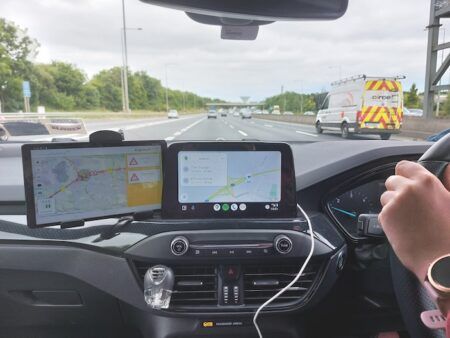Traffic Technology Today editor Tom Stone caught up with Tim Daniels (above), director of Videalert, to talk about clean air zones, the benefits of Videalert’s multifunctional, fully hosted platform enforcement solutions – and an unfortunate incident on London’s Conduit Street…
Perhaps you could start by telling us something about Videalert’s position in the market.
We were originally set up as a video analytics software company specializing in the security industry in 2006. But in 2008 there was a fairly significant recession going on and we felt there was a compelling return-on-investment case for refocusing on civil traffic enforcement. We were late entrants to the marketplace – the new kids on the block – but since delivering our first system in 2010 we’ve grown exponentially and become technology leaders. We were the first to deliver an unattended moving traffic enforcement system which went live at the London Borough of Redbridge in November 2013. We were the first to introduce an unattended parking enforcement system for school ‘keep clears’ in 2013 and we’ve now got in excess of 100 cameras deployed outside schools. We deployed the first fully hosted platform – not requiring any software or hardware to be installed on client premises – at Portsmouth City Council in March 2015. In March 2016, we announced our mobile enforcement vehicle, which enabled us to cover the full sweep of civil traffic enforcement solutions – attended, unattended and mobile enforcement – all of which run on our own platform. We were the first to do that and the first in our marketplace to have announced a clean air enforcement solution.
How can councils like Portsmouth (pictured above) benefit from working with Videaert’s fully hosted platform?
Councils can completely bypass their internal IT departments. Should a problem occur, it can be quickly resolved without having to wait for internal IT departments to respond. With our hosted solution, the installed cameras capture the offences then move them to the hosted platform where they can be accessed via any UK desktop with a standard web browser interface. Clients can then validate the evidence packs before they’re processed to the back office in the normal way. There is no IT involvement at all and minimal local authority involvement – their only responsibilities are the columns, the cameras and the power to the columns. The cameras can all be delivered as part of the managed service, in which case everything is maintained for the duration of the contract – making it very, very simple.
What is the background to Videalert’s Clean Air Zone (CAZ) solution and why did you decide to move in this direction?
Air quality has a huge impact on the health and welfare of citizens everywhere and, when you look at the data, it makes road safety deaths look almost insignificant in comparison. We think it is going to be one of the most pressing issues facing local authorities and governments. Hundreds of towns and cities are not meeting the EU targets for emission levels, so this is only going to get bigger. Obviously clean air, like any other enforcement activity, requires the ability to identify vehicles at the edge and filter results – in this case based on their level of emissions and Euro rating. This requires the use of analytics to check that correct tariffs have been paid or enforce against those vehicles not permitted to enter the CAZ. Videalert’s open platform intelligently captures VRM data, processes video and collates evidence packs for distribution to other third-party systems, which actually provides a perfect base for delivering our CAZ solution. We’re leveraging that backbone to deliver the required outcomes for CAZs.
Can you give us a step-by-step guide to how the system actually works?
Step One: VRMs are captured – if they’re not on a whitelist already as a permitted vehicle. Step Two: The captured VRMs are sent to the hosted platform where a database look-up is used to identify the vehicle classification – make, model, color, engine type, CO2 emissions, Euro rating and gross weight if it’s relevant. Step Three: vehicles of no interest are added to the white list and stored at the edge. Vehicles of interest are then filtered according to the tariff fee schedule and checked to ensure the correct payment has been made. Payment systems will have the concept of prepay – so people pay in advance – and they may allow a 24-48 hour period afterwards for payment to be made. The last step is that evidence packs are reviewed and then sent to the back office for issuing tickets or letters.
So what marks out the Videalert Clean Air Zone solution from potential competitors?
Firstly, the ability to deploy rapidly. The system can be installed with minimal infrastructure in place and leverages our hosted platform with little or no internal IT involvement from the council. The whitelist at the camera edge means if it sees that plate again, the system just disregards it; the system is self-learning, so you have to store less data and running costs are minimized. It’s fully digital, so the cameras and systems support the ONVIF (Open Network Video Interface Forum) digital standard for ensuring interoperability between IP devices. Because our cameras are high-definition it’s higher quality video which equates to higher capture rates and lower levels of appeal, because the video is irrefutable.
And this isn’t a standalone solution – but that the platform has many potential uses?
Correct. The company philosophy is to leverage the digital platform so you can easily add additional enforcement scenarios or traffic applications. The broad range of applications that can run simultaneously on the platform include moving traffic contraventions such as bus lanes, banned turns and box junctions along with school keep clears, unattended parking, tolling and restricted zones. In addition, Clean Air Zone cameras could be used for police intelligence, surveillance and crime prevention as well as facilitating improved traffic management in the cities. We have cameras on the main routes into Bristol which feed data to the council system as well as to the police. Customers can do more with less and adding functionality and value has to be good news.
What procurement options are available to authorities interested in Videalert’s enforcement solutions?
The customer can decide to buy the whole system – a capex [capital expenditure] type purchase – or they can do a partial capex whereby they purchase the equipment and pay a fixed rental for the hosted platform and the software. Alternatively, they can run it as what we call a ‘CCTV-enforcement-as-a-service’ – which is a full on-demand managed service with a fixed rental which covers everything and everything is maintained.
I believe you already have systems installed in London and multiple UK locations?
Yes. We’re running multiple applications from our platform for a number of clients.
I got caught by one a couple of weeks ago – maybe it was one of yours? It was at the top of Savile Row…
Conduit Street? Yes, that is one of our cameras!
I think the priorities had changed since I was last down there and it was ten o’clock on a Saturday morning – it was very quiet. I thought, ‘I’ll just cut across Conduit Street, it’ll be alright!’ The silly thing was, I could have turned left and done a U-turn, I think. Thanks, Tim!
Oh dear. Be careful! Don’t come back to me if you’ve got a ticket!
Yes, I have got a ticket – but it’s alright, I’ve paid it. It’s a fair cop! But I think that has changed, has it? It’s a shortcut I used to take, years ago now.
I feel terrible now. But you do know the system works, right?
It definitely works, yeah. It definitely works.
For more about the rapid growth in the need for enforcement of low emission zones in the UK and beyond don’t miss the new April/May 2017 edition of Traffic Technology International




